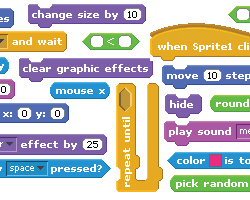Getting With the Program
Scratch Day at TC spreads the word about an intuitive visual language
By Siddhartha Mitter
They’re known as Scratchers. There are over 800,000 of them, and together they’ve designed close to two million projects. What’s a Scratcher? A student who uses Scratch—the programming language aimed at young people age eight and up that replaces abstract and cumbersome code with an intuitive visual language.
Using Scratch, which was developed at MIT four years ago, Scratchers create animations, games, simulations and other projects. They collaborate online. But they don’t always meet in person with each other and educators who have embraced the tool – which is why Scratch Day—an annual program of events held at MIT and sites around the world, including TC—was born.
At this year’s Scratch Day at TC, held on a Saturday in mid-May, a group of about 100 students, parents, teachers and researchers gathered at the College to learn new uses for Scratch, creating projects and sharing experiences from in and outside the classroom.
In the design workshop, junior high-schoolers Madison Empie, from Pennsylvania, and Kim McGuire, from New Jersey, were having fun building an animation around the story of how they met—at last year’s Scratch Day at TC event. “It was tons of fun,” Empie said. “We made projects, critiqued each other’s projects and learned tips from each other.”
Across the room, Jeff Just, from New Jersey, was watching as his home-schooled sons Sirius, a Scratch veteran, and Orion, a novice, talked with an instructor. “Scratch is just as flexible as many programming languages,” Just said. “It gives them a good base.”
Not everyone in computer science agrees, said Ursula Wolz, a professor of computer science and interactive media at The College of New Jersey who actively collaborates with the inventors of Scratch.
“The community is a bit prejudiced against it because it’s not a text-based language,” Wolz said. “The fact that you don’t have to worry about syntax is disconcerting. But what I like is that you can get past the basics. You just can’t make errors, which is lovely.”
Wolz said that new versions of Scratch are addressing some of the more substantive criticisms without losing the accessibility of the program, which lets learners set up ‘procedures,’ a kind of programmatic structure that is typically found in a more traditional syntax-based procedural programming.
Scratch is easy to use, but it’s also rigorous in its demands, said Tim Cooper, a teacher at Friends Seminary in New York. “Kids have to find a way to make it interactive. They have to have the user gain control and interaction with the game. And they have to put in feedback -- a score, or some glowing words. Once they master those principles, they can expand on them.
“People always think it’s great to learn programming,” Cooper said. “But it’s much better to use programming.”
Francesca Zammarano, a technology integrator at the Marymount School of New York, is intent upon getting Scratch into classrooms and putting it to use for teaching different subjects. “I’m the Scratch evangelist at my school,” Zammarano said.
She attended the TC event with five students from Marymount, who presented the games they had designed in Scratch to help teach the American Revolution. Quite a few of their sample questions about Revolutionary War arcana stumped the adults in the room.
“Sometimes the teachers don’t know Scratch, so they’re not comfortable with having it as the tool,” Zammarano said. But the students don’t have that problem. Zammarano has been teaching Scratch for four years and has learned to let the kids take the lead. “I just give them guidelines and see where they take it, and that’s what impresses me the most.”
Published Wednesday, Jun. 1, 2011
